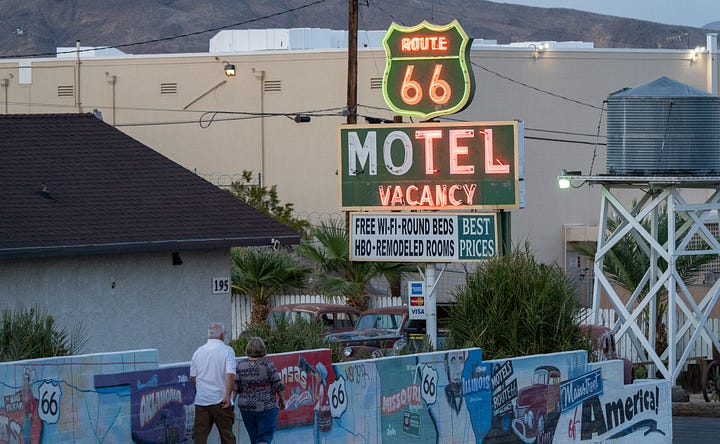Route 66 as a Symbol of the Elusive But Compelling American Dream: Hope. Toil. Sacrifice. Failure. Triumph. Enduring Faith.
No one can definitively describe the American Dream. It is a little bit different for everyone. But whatever it is, it has never been easy. Often elusive, it has always demanded work and sacrifice.
From the shores of Lake Michigan and the Great Lakes Region to the Pacific Ocean, the circa 2,500 mile highway known as Route 66 has been one of the enduring symbols of the American Dream. But what is the American Dream? Our essay traces the roots of the phrase and the migration of its meaning … and meaningfulness. Not just in the past. If the term was ever truly relevant in the past, it might be even more relevant as America and Americans, look forward to the future. Our proposition is that America — the bold experiment in democracy, freedom, and egalitarianism — is not only not nearing the end of its journey, it has only just begun.


About 70% of travellers along Route 66 are from outside the United States. I am from outside the United States, and thus, I can offer an outsider’s perspective - which has merits and deficits for exactly the same reasons. Although a visitor, I am not merely a dilettante when it comes to exploring and appreciating this country. Over the past five years, I have driven well over 200,000 miles criss-crossing its highways and byways in my Ram 1500, in addition to very many airline flights to all corners. Spanning more than three decades in my own vehicles and rentals, my cumulative miles are in the many hundreds of thousands. Further, my encounters with Americans from all states and socio-economic, religious, racial, and political perspectives number in the thousands.
As a result, my own perspective is that the thing we call the American Dream has become confused in recent years with the idea of entitlement.
That’s not what it is or what it meant, or what it should mean, not at all. The American Dream does not and never has meant entitlement. It does equal hope. It does equal rule of law. It is very much aligned with the egalitarian notion that anyone can make it — whatever “it” means to them. It’s the belief that they — we — he — she — anyone — can break through barriers of any kind. But it’s also hard. It has to be earned, worked for, sweated for, believed in, enduring failure and setbacks, testing one’s faith and resilience. It’s the product of toil, not a gift, not a right. It’s a privilege. An outcome of persistent faith and work. It is also inextricably connected with the idea of one nation under God, which was the very foundation of this country.
There is a pivotal line in the 1995 movie, The American President, with Michael Douglas and Annette Bening. Speaking of the challenges of living in and maintaining a democracy, President Andrew Shepherd (Michael Douglas) says, “America isn't easy. America is advanced citizenship. You gotta want it bad, 'cause it's gonna put up a fight.” The very same “want” is true of the notion of the American Dream. President Shepherd’s speech goes on to say, “Let's see you acknowledge a man whose words make your blood boil, who's standing center stage and advocating at the top of his lungs that which you would spend a lifetime opposing at the top of yours. You want to claim this land as the land of the free? Then the symbol of your country can't just be a flag; the symbol also has to be one of its citizens exercising his right to burn that flag in protest. Show me that, defend that, celebrate that in your classrooms. Then, you can stand up and sing about the "land of the free.””
The screenwriter for The American President was Aaron Sorkin, principal writer for the famous television series, The West Wing. Sorkin’s observations are true regarding democracy, regardless of one’s political perspective. But they also highlight the real truth about the American Dream: it has to be wanted, nurtured, demanded, worked for, not expected as a right or a free gift; not an entitlement.
During my many years and miles of travel, I’ve driven the length of Route 66 in full, and traveled it in sections, many times. To me, Route 66 is a perfect symbol of the American Dream. Some people, and some of the towns along its route celebrate its history, others have forgotten or tend to ignore that past held in yesteryear. Some parts are vibrant and refreshed. Some parts are mere relics, cracked, neglected, forgotten. Some, have almost disappeared entirely.
The essay which follows offers a detailed and nuanced framework for the origin and progression of the idea of the American Dream. Ultimately, the American Dream is an attitude, a choice. It’s alive and vibrant for those who “want” it. And it is somewhat diminished for those who have never had the vision, or lost the vision, or feel entitled and wonder what happened to that elusive idea, just like Route 66.






The American Dream: a Nuanced Analysis
1. Introduction: Deconstructing the American Dream
The "American Dream" stands as a pervasive ideal within the United States, a concept deeply embedded in the nation's identity and aspirations.1 However, this seemingly straightforward phrase belies a complex and multifaceted nature, encompassing a wide array of hopes, beliefs, and ambitions. It is not a monolithic concept but rather a dynamic and often contested one, subject to varying interpretations across individuals and throughout history. This essay aims to provide a comprehensive and explicit definition of the American Dream by dissecting its core components, tracing its historical evolution, exploring its diverse interpretations through economic, social, and political lenses, examining its perception among different demographic groups within the US, investigating the contemporary challenges hindering its achievement, analyzing its portrayal in popular culture, and elucidating its intricate relationship with fundamental American values such as equality, freedom, and individual success.
Initial understandings of the American Dream often paint a picture of the United States as a "land of opportunity" 1, a place where upward mobility, freedom, and equality are attainable for people of all classes who are willing to work hard and possess the determination to succeed.1 This notion is intrinsically linked to the foundational principles of the nation, with tenets of the American Dream traceable back to the Declaration of Independence and its emphasis on the pursuit of happiness.2 Even in its early conceptualizations, the American Dream extended beyond mere material acquisition. For instance, James Truslow Adams, who popularized the term, emphasized a "better and richer and fuller life" for everyone and the opportunity for individuals to "attain to the fullest stature of which they are innately capable" regardless of their birth circumstances.2 This suggests that from its inception, the American Dream encompassed aspirations for personal growth and societal recognition based on merit, rather than solely focusing on financial gain. Furthermore, the meaning and interpretation of the American Dream have not remained static. Its definition has been a subject of ongoing debate and has undergone considerable transformations over time 3, necessitating a thorough exploration of these historical shifts to arrive at a comprehensive understanding of its contemporary significance.
2. Defining the Core Tenets
The American Dream, in its essence, is built upon several fundamental components that have been consistently identified across various analyses.1 These core tenets provide a framework for understanding the aspirations and beliefs associated with this enduring American ideal.
The United States is often characterized as a "land of opportunity" 1, suggesting that individuals, regardless of their origins or socioeconomic status, have the chance to improve their lives and achieve their goals.4 This idea of opportunity was particularly compelling for early immigrants who were drawn to the New World by the promise of escaping rigid social hierarchies prevalent in Europe.2 Unlike the societies they left behind, where birth often dictated one's destiny, America was perceived as a place where individuals could forge their own paths and attain a better future through their own efforts. This historical contrast significantly shaped the initial understanding of the American Dream, emphasizing the potential for advancement unconstrained by the circumstances of one's birth.
A central component of the American Dream is the belief in social mobility 1, the idea that individuals can move upward in social and economic status through hard work, determination, and ambition.4 This tenet suggests a dynamic society where one's starting point does not necessarily determine their final destination. However, while social mobility remains a core aspect of the American Dream, its actual prevalence and the perception of its attainability have shifted over time and vary considerably across different demographic groups.3 Research indicates a notable decline in upward mobility in recent decades 21, suggesting a potential divergence between the ideal of readily available social advancement and the lived experiences of many Americans.
The aspiration for prosperity and financial success is another significant facet of the American Dream.1 This often entails the desire for a better and more comfortable life, marked by financial security and material well-being, such as owning a home and securing a stable job.2 Over time, the emphasis on material prosperity appears to have become more pronounced in popular interpretations of the American Dream 2, potentially overshadowing the original emphasis on broader social order and personal fulfillment. This shift towards a more materialistic view may be attributed to factors such as increased consumerism and evolving economic landscapes.
The ideal of equality is also deeply embedded in the American Dream, particularly the concept of equal opportunity.1 This suggests a society where everyone has a fair chance to succeed, free from barriers based on birth, social status, race, religion, or other arbitrary circumstances.3 This principle is rooted in the foundational statement of the Declaration of Independence that "all men are created equal".2 However, the concept of equality within the American Dream is complex, encompassing not only "equality of opportunity" but also the historical and ongoing struggle for broader social and political equality for all demographic groups.3 The pursuit of the American Dream has often been intertwined with movements for civil rights and social justice, reflecting the continuous efforts to ensure its promise extends to every member of society.
Freedom, in its various forms, plays a crucial role in the American Dream.1 The Declaration of Independence enshrines the rights to "life, liberty, and the pursuit of happiness" 2, which are fundamental to the American ethos. Within the context of the American Dream, freedom is interpreted as both the freedom to achieve one's aspirations and the freedom from oppression or undue constraints.2 This encompasses personal liberties, economic freedoms to pursue opportunities, and political freedoms within a democratic framework.
Finally, the American Dream places a strong emphasis on individual success 1, with a prevailing belief that personal effort, hard work, and determination are the primary drivers for achieving one's goals and attaining a better life.2 The narrative of the "self-made man" or "self-made woman" epitomizes this aspect of the American Dream.6 However, this strong emphasis on individual achievement can sometimes obscure the significant role of systemic factors and societal inequalities in shaping life outcomes 29, leading to criticisms of the American Dream as an ideology that may not fully account for the complexities of social and economic realities.
3. A Historical Journey
The term "American Dream," while deeply ingrained in the national consciousness, has a history that stretches back to the nation's early days, with its meaning evolving alongside the country itself. Tracing the origins and transformations of this concept provides crucial context for understanding its contemporary significance.
The roots of the American Dream can be found in the 18th and 19th centuries, during the nation's formative years.3 The colonial era fostered a sense of mystique surrounding frontier life, with the vast expanse of land offering the promise of a fresh start and opportunities not readily available in the Old World.3 The Declaration of Independence in 1776, with its proclamation of the rights to life, liberty, and the pursuit of happiness, further solidified the idea of a nation founded on principles of individual aspiration and potential.3 For many immigrants seeking religious and political freedom, the United States represented an escape from oppressive regimes and rigid social structures.3 The availability of land and the absence of entrenched aristocracy offered the allure of a society where one's fate was not predetermined by birth. In the 19th century, the discovery of gold in California sparked the "California Dream," which introduced the element of rapid wealth acquisition through audacity and luck, further diversifying the interpretations of the American Dream.3
The phrase "American Dream" gained widespread popularity in the 20th century, particularly during the Great Depression, with the publication of James Truslow Adams's Epic of America in 1931.2 Adams defined it not merely as a dream of material wealth but as "that dream of a land in which life should be better and richer and fuller for everyone, with opportunity for each according to ability or achievement".2 His vision was rooted in the idea of social order and collective well-being, where individuals could reach their full potential regardless of their social standing.5 This emphasis on "commonweal" and a moral dimension of the American Dream contrasts with the later, more prevalent focus on individual upward mobility.
In the post-World War II era, the American Dream became increasingly associated with the rise of consumerism and the ideal of a middle-class lifestyle.2 The image of a suburban home with a white picket fence, a car, and a steadily increasing income became a powerful symbol of achievement and security.8 Homeownership, in particular, was heavily promoted as a cornerstone of the American Dream.2 This period saw the American Dream largely defined by economic stability and material possessions.
The contemporary evolution of the American Dream reveals a continued transformation, with increasing attention being paid to factors beyond traditional markers of success.2 Access to quality education and healthcare are now frequently cited as essential components.2 There is also a growing recognition of the importance of personal fulfillment, community contribution, and overall well-being, potentially indicating a shift away from purely materialistic definitions of success.7 Notably, younger generations may hold a different understanding of the American Dream, prioritizing factors such as individual identity and purpose alongside, or even instead of, traditional milestones like marriage and homeownership.9 This ongoing evolution underscores the dynamic and adaptable nature of the American Dream as it continues to be shaped by changing societal values and economic realities.
4. Perspectives on the Promise
The American Dream is a concept viewed through various lenses, each offering a distinct interpretation of its meaning and significance. Examining these economic, social, and political perspectives reveals the complexity and multifaceted nature of this ideal.
From an economic perspective, the American Dream is often interpreted through the lens of financial success, the principles of a free market economy, the spirit of entrepreneurship, and the potential for economic mobility.2 This viewpoint emphasizes the belief that through hard work, risk-taking, and determination, individuals can achieve financial well-being and improve their economic standing.2 The opportunity to accumulate wealth, own property (particularly a home), and secure a comfortable life are central to this interpretation.2 The economic interpretation is arguably the most dominant in popular discourse, frequently equating the American Dream with attaining a middle-class lifestyle or even significant wealth.8 However, there is a growing concern, supported by substantial evidence, that the economic aspects of the American Dream are becoming increasingly challenging to realize for many Americans.21 Factors such as wage stagnation, rising costs of living, and increasing income inequality are contributing to a perception that the traditional economic markers of the American Dream are becoming less attainable.21 Furthermore, research suggests that many Americans overestimate the ease of upward economic movement, indicating a potential misalignment between the perceived and actual levels of economic mobility in the United States.30
The social perspective on the American Dream focuses on interpretations related to equality, social mobility, the importance of community, and individual fulfillment that extends beyond purely economic measures.3 This viewpoint emphasizes the opportunity for personal growth and the ability to achieve one's full potential, irrespective of the circumstances of birth or social background.2 The ideal of a society where individuals are judged by their abilities and achievements rather than their social standing is central to this perspective.3 Social mobility, the capacity to improve one's socioeconomic status, is a key element, representing the hope for a better future for oneself and one's children.3 However, critics argue that the American Dream's emphasis on individualism can mask underlying systemic social inequalities, such as those based on race, gender, and socioeconomic status, and may place undue blame on individuals for a lack of success without acknowledging these broader societal constraints.3 It is also observed that younger generations may define the social aspects of the American Dream differently, potentially prioritizing community engagement, strong social relationships, and personal well-being over purely individualistic achievements.9
The political perspective on the American Dream examines interpretations related to democracy, freedom, rights, and the role of government in creating an environment conducive to its achievement.2 This viewpoint underscores the deep intertwining of the American Dream with the fundamental political ideals of the United States, particularly the promise of a society where individual rights and freedoms are protected and upheld by a democratic government.2 The Declaration of Independence and the Constitution provide the foundational framework for these rights and freedoms, which are seen as essential for enabling individuals to pursue their aspirations.2 However, different political ideologies hold varying perspectives on the appropriate role of government in either facilitating or hindering the realization of the American Dream.7 Debates often arise regarding the extent to which government intervention, through policies related to economic regulation, social welfare, and equal opportunity, is necessary or detrimental to the pursuit of individual success. Furthermore, the concept of "American exceptionalism," the belief that the United States is unique in its opportunities and ideals, is often linked to the American Dream within the political discourse.3
5. A Nation of Diverse Views
Perceptions of the American Dream are not uniform across the United States; they vary significantly among different demographic groups, reflecting their diverse experiences and realities within American society. Examining these variations reveals important disparities in optimism and the perceived attainability of this ideal.
Age plays a significant role in shaping how individuals perceive the American Dream.6 Generally, older Americans tend to express greater optimism about its attainability compared to younger adults.6 For instance, a recent survey indicated that approximately two-thirds of adults aged 65 and older believe the American Dream is still possible, while only about four-in-ten adults under 50 share this view.44 This difference in optimism between age cohorts may reflect their lived experiences across different economic and social periods.38 Older generations may have witnessed periods of greater economic mobility and stability, shaping their belief in the enduring promise of the American Dream.
Income levels also strongly influence the perception of the American Dream.6 Higher-income Americans are considerably more likely to believe that the American Dream remains achievable compared to their lower-income counterparts.23 Data shows a substantial gap in optimism, with a significantly higher percentage of upper-income individuals believing in the American Dream's attainability than those in lower-income brackets.44 This correlation between income and belief in the American Dream underscores the potential impact of economic realities on individual perceptions of opportunity.23 Financial security and stability appear to play a crucial role in how individuals assess their own chances and the chances of others in achieving the American Dream.
Perceptions of the American Dream also differ across racial and ethnic groups.6 While roughly half of Americans across various racial and ethnic groups believe the American Dream is still possible, there are notable differences in other aspects of their views.44 For example, Black Americans are approximately twice as likely as other groups to say that the American Dream was never possible.44 These differing views likely reflect the historical and ongoing systemic inequalities that have disproportionately affected marginalized communities' access to opportunity and upward mobility.5
Political affiliation and educational attainment also show some correlation with perceptions of the American Dream.6 While the differences are relatively modest, Republicans tend to be slightly more optimistic about the American Dream's attainability than Democrats.44 Similarly, adults with a bachelor's degree or higher education are somewhat more likely to believe in the American Dream compared to those with less education.44 These differences might reflect varying beliefs about the role of government in addressing economic and social issues, as well as the perceived impact of education on individual success.37
6. The Cracks in the Foundation
Despite its enduring appeal, the American Dream faces significant challenges and criticisms in contemporary society, raising questions about its attainability for many Americans.
One of the most prominent challenges is the increasing income inequality and the widening wealth gap.5 Data indicates a substantial increase in the wealth gap between the richest and poorest families in the United States over the past few decades.47 This growing disparity creates unequal starting points for individuals and limits opportunities for those from lower socioeconomic backgrounds, making upward mobility considerably more difficult.23 The concentration of wealth at the top can hinder the ability of others to achieve financial security and improve their circumstances.
Compounding this issue is the documented decline in social mobility.3 Research shows a significant decrease in the likelihood of children earning more than their parents compared to previous generations.5 This decline directly challenges a core promise of the American Dream – that future generations will have better opportunities and a higher standard of living than their predecessors.21
The soaring costs of education and healthcare also present significant barriers to achieving the American Dream.2 The increasing burden of student loan debt, which has reached staggering levels, can delay or even deter young adults from pursuing their aspirations and achieving financial stability.41 Similarly, the high costs of healthcare can create financial strain and insecurity, potentially derailing individuals' pursuit of a better life.2
Furthermore, systemic barriers and discrimination based on factors such as race, gender, and socioeconomic background continue to impede the American Dream for many.3 The American Dream has historically not been equally accessible to all, and persistent inequalities create significant obstacles for marginalized communities.3 These systemic issues challenge the notion of a level playing field and raise critical questions about the inclusivity and fairness of the American Dream in practice.
7. The Dream on Screen and Page
The American Dream has long been a recurring theme in popular culture, with literature, film, and media offering diverse portrayals that reflect both its allure and its potential pitfalls.
Literature has frequently explored the complexities of the American Dream, often serving as a critical lens on its promises and realities.2 Classic works like F. Scott Fitzgerald's The Great Gatsby depict the pursuit of wealth as a potentially corrupting force, highlighting the emptiness that can accompany the materialistic interpretation of the Dream.45 Arthur Miller's Death of a Salesman portrays the tragic consequences of chasing an unattainable version of the American Dream based on superficial success.45 In contrast, some literature, particularly narratives focused on the immigrant experience, often emphasizes the hope and determination associated with seeking a better life in America.56 Works like The Autobiography of Benjamin Franklin present a more optimistic view, illustrating the possibility of upward mobility through hard work and ingenuity.45 Overall, literature provides a nuanced exploration of the American Dream, encompassing both its inspiring potential and its inherent contradictions.
Film, similar to literature, offers a wide range of portrayals of the American Dream.2 Films like Citizen Kane and The Wolf of Wall Street explore themes of ambition, wealth, and the potential moral compromises involved in achieving a distorted version of the Dream.63 Others, such as Forrest Gump, present a more unconventional and perhaps more attainable vision of success and fulfillment within the American context.67 Films like Minari delve into the immigrant experience and the challenges of pursuing the American Dream while navigating cultural differences and economic hardships.69 The cinematic landscape reflects the ongoing debate surrounding the American Dream, presenting both idealized narratives of triumph and critical examinations of its darker aspects and unattainability for some.
Contemporary media, particularly social media, has emerged as a powerful force in shaping perceptions of the American Dream.3 Social media platforms often showcase curated images of success, frequently emphasizing financial wealth and seemingly effortless lifestyles, which can influence how young people, in particular, understand the American Dream.49 The rise of social media influencers as aspirational figures further highlights this trend.50 However, some media also offer more critical perspectives, challenging traditional notions of success and portraying the realities of financial struggles and systemic inequalities.50 Notably, research suggests that media portrayals can sometimes perpetuate inaccurate representations of social mobility and the experiences of different demographic groups, potentially shaping perceptions in ways that do not align with actual societal realities.73
8. The American Dream and its Foundational Values
The American Dream is inextricably linked to the core values upon which the United States was founded: equality, freedom, and individual success. Examining this relationship reveals areas of alignment as well as inherent tensions.
The American Dream is fundamentally predicated on the ideal of equal opportunity.2 The belief that everyone should have a fair chance to succeed, regardless of their background, is central to its promise.3 However, the reality of unequal outcomes in American society raises critical questions about whether this ideal of equal opportunity is truly realized for all.20 The persistent disparities in wealth, income, education, and other key indicators suggest that the playing field may not be level, leading to ongoing debates about how to achieve a more equitable society where the American Dream is genuinely accessible to everyone.
Freedom, in its various dimensions, is another cornerstone of both American identity and the pursuit of the American Dream.1 The American Dream can be viewed as an expression of individual liberty, allowing people the autonomy to define and pursue their own version of success and happiness.2 This encompasses the freedom to make personal choices, pursue economic opportunities, and express oneself without undue constraint.2 The protection of these freedoms is considered essential for creating an environment where individuals can strive for a better life and realize their full potential.
The American Dream places a strong emphasis on individual success, deeply rooted in the belief in hard work and self-reliance.1 The notion that personal effort and determination are the primary drivers of achievement is a central tenet.2 This emphasis on individual agency and responsibility has been a powerful motivating force in American culture. However, some argue that this strong focus on individual success can sometimes lead to a neglect of the social safety net and a diminished sense of collective responsibility for those who face significant challenges and hardships.25 The tension lies in balancing the importance of individual initiative with the recognition that systemic factors and societal support also play crucial roles in determining life outcomes.
9. Synthesizing the Definition
The American Dream is a multifaceted national ethos of the United States, deeply rooted in the Declaration of Independence's promise of life, liberty, and the pursuit of happiness.2 Originally conceived as a vision of a better, richer, and fuller life for all citizens, characterized by social order and the opportunity for individuals to reach their full potential regardless of their birth circumstances, it has evolved to encompass ideals of opportunity, upward social mobility, and prosperity achieved through hard work and determination within a framework of freedom and equality.2 While often associated with economic success and material well-being, the American Dream also carries significant social and political dimensions, emphasizing personal fulfillment, community contribution, and the protection of individual rights.2 However, its attainability is increasingly challenged by contemporary issues such as rising income inequality, declining social mobility, and systemic barriers, leading to diverse perceptions across demographic groups and ongoing debates about its true meaning and future.5
10. Conclusion: The Enduring Legacy and Evolving Future
The nuanced analysis presented in this essay underscores the multifaceted and dynamic nature of the American Dream. It is a concept that has evolved significantly since its early conceptualizations, reflecting the changing social, economic, and political landscapes of the United States. While initially rooted in ideals of opportunity and a better life beyond material wealth, the American Dream has become increasingly associated with economic success and upward mobility. However, contemporary challenges such as rising income inequality, declining social mobility, and persistent systemic barriers have led to widespread concerns about its attainability for many Americans, particularly among younger generations and marginalized communities.
Despite these challenges and criticisms, the American Dream retains a powerful and enduring legacy as a central tenet of American identity.20 It continues to shape individual aspirations and national narratives, serving as a benchmark against which societal progress is often measured. The diverse interpretations of the American Dream, as seen through economic, social, and political lenses, highlight its complexity and the ongoing debates surrounding its meaning and relevance in the 21st century.
The future trajectory of the American Dream will likely continue to evolve. Addressing the contemporary challenges to its realization is crucial to ensuring that it remains a meaningful and attainable aspiration for all Americans. This may involve policy interventions aimed at reducing income inequality, promoting social mobility, improving access to education and healthcare, and dismantling systemic barriers that hinder opportunity. Ultimately, the enduring power of the American Dream lies in its capacity to inspire hope and motivate individuals to strive for a better future, but its continued relevance depends on the nation's commitment to upholding the foundational values of equality and freedom, opportunity for every citizen, and the faith in God upon which the nation was founded and its rule of law established. § prr



Enjoy this analysis of the above Veritas Chronicles essay about Route 66 — it’s an interesting and fun listen …
References —
www.britannica.com, accessed April 13, 2025, https://www.britannica.com/topic/American-Dream#:~:text=American%20Dream%2C%20ideal%20that%20the,have%20the%20will%20to%20succeed.
What Is the American Dream? Examples and How to Measure It - Investopedia, accessed April 13, 2025, https://www.investopedia.com/terms/a/american-dream.asp
American Dream - Wikipedia, accessed April 13, 2025, https://en.wikipedia.org/wiki/American_Dream
American Dream - Defined, History, Changes, Origin - Corporate Finance Institute, accessed April 13, 2025, https://corporatefinanceinstitute.com/resources/economics/american-dream/
American Dream | Definition, Examples, & In Literature | Britannica, accessed April 13, 2025, https://www.britannica.com/topic/American-Dream
The American Dream - (English 9) - Vocab, Definition, Explanations | Fiveable, accessed April 13, 2025, https://library.fiveable.me/key-terms/english-9/the-american-dream
What is the American Dream Today & How It's Changed - RealWealth, accessed April 13, 2025, https://realwealth.com/learn/what-is-the-american-dream-today/
A Brief History of the American Dream | George W. Bush Presidential Center, accessed April 13, 2025, https://www.bushcenter.org/catalyst/state-of-the-american-dream/churchwell-history-of-the-american-dream
Defining the American Dream: A Generational Comparison - UTC Scholar, accessed April 13, 2025, https://scholar.utc.edu/cgi/viewcontent.cgi?article=1503&context=mps
An Older Definition of the American Dream | Institute for Family Studies, accessed April 13, 2025, https://ifstudies.org/blog/an-older-definition-of-than-older-definition-of-the-american-dreame-american-dream
Economic Opportunity and Social Mobility, accessed April 13, 2025, https://cosm.aei.org/economic-opportunity-and-social-mobility/
How Does the American Dream Influence the U.S. Economy? - Investopedia, accessed April 13, 2025, https://www.investopedia.com/ask/answers/061815/how-does-notion-american-dream-influence-us-economy.asp
How the "American Dream" has Changed for Young Americans - Close Up Foundation, accessed April 13, 2025, https://www.closeup.org/for-young-americans-the-american-dream-resonates-differently/
Freedom and the American Dream - John Locke Foundation, accessed April 13, 2025, https://www.johnlocke.org/freedom-and-the-american-dream/
The American Dream starts with one small step - Americans for Prosperity, accessed April 13, 2025, https://americansforprosperity.org/blog/why-the-american-dream-starts-with-one-small-step/
Embracing the American Dream: The Essence of Freedom and Self-Expression | NMSHSA, accessed April 13, 2025, https://www.nmshsa.org/blog/internship/embracing-american-dream-essence-freedom-and-self-expression
Freedom is the American Dream | Representative Tom Cole, accessed April 13, 2025, https://cole.house.gov/media-center/weekly-columns/freedom-is-american-dream
A Freedom Worth Celebrating: The American Dream - DIServices, accessed April 13, 2025, https://www.diservices.com/blog-disability-insurance/a-freedom-worth-celebrating-the-american-dream
The American Dream as the Vision Statement for the United States - Profectus Magazine, accessed April 13, 2025, https://profectusmag.com/the-american-dream-as-the-vision/
American Dream 2024 Snapshot: The Health and State of the American Dream, accessed April 13, 2025, https://www.archbridgeinstitute.org/american-dream-snapshot/
Is the American Dream over? Here's what the data says - The World Economic Forum, accessed April 13, 2025, https://www.weforum.org/stories/2020/09/social-mobility-upwards-decline-usa-us-america-economics/
The American Dream is less of a reality today in the United States, compared to other peer nations, accessed April 13, 2025, https://equitablegrowth.org/the-american-dream-is-less-of-a-reality-today-in-the-united-states-compared-to-other-peer-nations/
The Reality of the American Dream - Exhibit, accessed April 13, 2025, https://www.exhibit.xavier.edu/cgi/viewcontent.cgi?article=1024&context=xjur
"The American Dream, Equal Opportunity, and Obtaining the Vote " by Benjamin Wyman, accessed April 13, 2025, https://digitalcommons.library.umaine.edu/tcj/vol1/iss1/4/
Defining the Dream: A Larger Vision for America and Americans - National Civil Rights Museum, accessed April 13, 2025, https://www.civilrightsmuseum.org/50-voices-for-50-years/posts/defining-the-dream
Equality and the American Dream - C. Bradley Thompson, accessed April 13, 2025, https://cbradleythompson.com/equality-and-the-american-dream/
The End of the American Dream? Inequality and Segregation in US Cities, accessed April 13, 2025, https://bfi.uchicago.edu/insight/research-summary/the-end-of-the-american-dream-inequality-and-segregation-in-us-cities/
Created Equal: Exclusion and Inclusion in the American Dream | The Fetzer Institute, accessed April 13, 2025, https://fetzer.org/resources/created-equal-exclusion-and-inclusion-american-dream
How the American dream turned into greed and inequality - The World Economic Forum, accessed April 13, 2025, https://www.weforum.org/stories/2017/11/the-pursuit-of-happiness-how-the-american-dream-turned-into-greed-and-inequality/
How Fair Is American Society? | Yale Insights, accessed April 13, 2025, https://insights.som.yale.edu/insights/how-fair-is-american-society
The American Dream: What It Means and Why It's Important - Intellectual Takeout, accessed April 13, 2025, https://intellectualtakeout.org/2024/02/american-dream-what-it-means/
What Really is the American Dream? - APSA Preprints, accessed April 13, 2025, https://preprints.apsanet.org/engage/api-gateway/apsa/assets/orp/resource/item/5eed251f042e630019ecb22c/original/what-really-is-the-american-dream.pdf
The American Dream - What is Social Studies?, accessed April 13, 2025, https://socialstudieshelp.com/american-history-topics/the-american-dream/
American Sociology's Investigations of the American Dream: Retrospect and Prospect, accessed April 13, 2025, https://www.researchgate.net/publication/273518824_American_Sociology's_Investigations_of_the_American_Dream_Retrospect_and_Prospect
The Illusion of the American Dream: How the American Dream Fails to Acknowledge Inequality - Engaged Sociology, accessed April 13, 2025, https://engagedsociology.wordpress.com/2018/04/30/the-illusion-of-the-american-dream-how-the-american-dream-fails-to-acknowledge-inequality/
The American Dream in History, Politics, and Fiction, accessed April 13, 2025, https://scielo.org.za/scielo.php?script=sci_arttext&pid=S2223-03862023000200009
Voting on the American Dream | Working-Class Perspectives, accessed April 13, 2025, https://workingclassstudies.wordpress.com/2012/09/12/voting-on-the-american-dream/
Public Opinion and the American Dream | American Enterprise Institute - AEI, accessed April 13, 2025, https://www.aei.org/articles/public-opinion-american-dream/
The American Dream Isn't Dead, It's Just Misunderstood, accessed April 13, 2025, https://americancompass.org/american-dream-isnt-dead/
Navigating Personal Growth While Pursuing the American Dream, accessed April 13, 2025, https://www.economicimpactcatalyst.com/blog/navigating-personal-growth-while-pursuing-the-american-dream
Access to Higher Education Makes the American Dream a Reality | Edcor, accessed April 13, 2025, https://www.edcor.com/blog/access-to-higher-education-makes-the-american-dream-a-reality/
The Psychology of the American Dream, accessed April 13, 2025, https://www.psychologytoday.com/us/blog/psychology-yesterday/201610/the-psychology-the-american-dream
Chasing the American Dream: | Understanding What Shapes Our Fortunes, accessed April 13, 2025, https://confrontingpoverty.org/research/chasing-the-american-dream-understanding-what-shapes-our-fortunes/
Americans are split over the state of the American dream - Pew Research Center, accessed April 13, 2025, https://www.pewresearch.org/short-reads/2024/07/02/americans-are-split-over-the-state-of-the-american-dream/
Literary Themes American Dream, accessed April 13, 2025, https://literacle.com/literary-themes-american-dream/
how the themes of self-reliance and individualism in American literature are relevant in pres - Digital Commons@DePaul, accessed April 13, 2025, https://via.library.depaul.edu/cgi/viewcontent.cgi?article=1169&context=etd
What is The American Dream? (Statistics, Income Mobility ..., accessed April 13, 2025, https://www.peakframeworks.com/post/american-dream
The Costs of the American Dream - Omnia - University of Pennsylvania, accessed April 13, 2025, https://omnia.sas.upenn.edu/story/costs-american-dream
The Truman Show and Commodifying the White American Dream - FSU Student Union, accessed April 13, 2025, https://union.fsu.edu/movies/blog/Truman
American Dream Study — Center for Scholars & Storytellers @ UCLA, accessed April 13, 2025, https://www.scholarsandstorytellers.com/american-dream
Chetty and Sandel take on the American Dream - Harvard Gazette, accessed April 13, 2025, https://news.harvard.edu/gazette/story/2023/10/chetty-and-sandel-take-on-the-american-dream/
Perception versus reality: What Americans think about economic mobility, accessed April 13, 2025, https://journalistsresource.org/economics/american-dream-reality-economic-mobility/
Ensuring the American Dream - International Monetary Fund (IMF), accessed April 13, 2025, https://www.imf.org/en/Publications/fandd/issues/2022/06/ensuring-the-american-dream-chetty-hendren
Theme of the American Dream in Literature: Guide & Topics - Custom-Writing.org, accessed April 13, 2025, https://custom-writing.org/blog/american-dream-in-literature
Popular American Dream Books - Goodreads, accessed April 13, 2025, https://www.goodreads.com/shelf/show/american-dream
American Dream Book Club Recs : r/ELATeachers - Reddit, accessed April 13, 2025, https://www.reddit.com/r/ELATeachers/comments/1fgl0b5/american_dream_book_club_recs/
10 Classic Stories About the Fall of the American Dream - Thoughts on Papyrus, accessed April 13, 2025, https://thoughtsonpapyrus.com/2024/09/10/10-classic-stories-about-the-fall-of-the-american-dream/
Literature with American Dream as a theme: anything I have missed?, accessed April 13, 2025, https://forums.welltrainedmind.com/topic/728689-literature-with-american-dream-as-a-theme-anything-i-have-missed/
12 Books That Explore and Expose The “American Dream” - She Reads, accessed April 13, 2025, https://shereads.com/12-books-that-explore-and-expose-the-american-dream/
What are some books that deal heavily with the American Dream? - Reddit, accessed April 13, 2025, https://www.reddit.com/r/books/comments/1qwz6v/what_are_some_books_that_deal_heavily_with_the/
The Illusion of the American Dream | 25YL - Film Obsessive, accessed April 13, 2025, https://filmobsessive.com/film/film-features/film-lists-rankings/the-illusion-of-the-american-dream/
Erin Whittington- "The American Dream Reflected Through Film" - Chênière: The Nicholls Undergraduate Humanities Review, accessed April 13, 2025, https://www.nicholls.edu/cheniere/2024/09/27/erin-whittington-the-american-dream-reflected-through-film/
10 Best Movies That Break Down the American Dream, Ranked - Collider, accessed April 13, 2025, https://collider.com/movies-break-down-american-dream-best-ranked/
These 10 Movies Perfectly Capture The Essence Of The American Dream - Screen Rant, accessed April 13, 2025, https://screenrant.com/movies-perfectly-capture-essence-american-dream-list/
What film best captures the essence of the American Dream? : r/Letterboxd - Reddit, accessed April 13, 2025, https://www.reddit.com/r/Letterboxd/comments/1ixbjx7/what_film_best_captures_the_essence_of_the/
20 Movies That Reveal a Darker Side of the American Dream - MovieWeb, accessed April 13, 2025, https://movieweb.com/movies-about-darker-side-of-american-dream/
Forrest Gump: A New Kind of American Dream | Film Obsessive, accessed April 13, 2025, https://filmobsessive.com/film/film-features/film25yl/forrest-gump-a-new-kind-of-american-dream/
movies about the American Dream? : r/MovieSuggestions - Reddit, accessed April 13, 2025, https://www.reddit.com/r/MovieSuggestions/comments/1b8pxig/movies_about_the_american_dream/
Minari and the American dream - The Vermont Cynic, accessed April 13, 2025, https://vtcynic.com/culture/arts/reviews/minari-and-the-american-dream/
A Portrait of the American Dream: A film by Ralph Lauren - YouTube, accessed April 13, 2025,
All About The Benjamins: 10 Best Movies About The American Dream - Collider, accessed April 13, 2025, https://collider.com/best-movies-about-the-american-dream/
Films, shows, music that address the 'American Dream' and the idealization of the US in an updated (beyond the 80s at least) and critical way? : r/ifyoulikeblank - Reddit, accessed April 13, 2025, https://www.reddit.com/r/ifyoulikeblank/comments/m3h1g3/films_shows_music_that_address_the_american_dream/
The American Dream is more attainable for TV characters than Americans | UCLA, accessed April 13, 2025, https://newsroom.ucla.edu/releases/american-dream-and-tv
The American Dream and Popular Culture – U.S. History II: 1877 to Present, accessed April 13, 2025, https://fscj.pressbooks.pub/modernushistory/chapter/the-american-dream-and-popular-culture/
Why Social Media Influencers Are The New American Dream - Neuroscience Of, accessed April 13, 2025, https://www.neuroscienceof.com/human-nature-blog/social-media-influencer-american-dream





